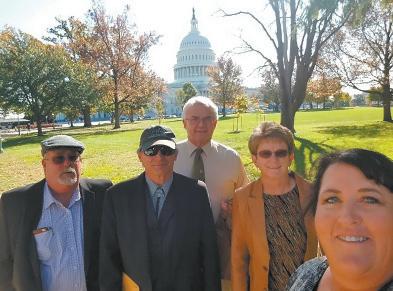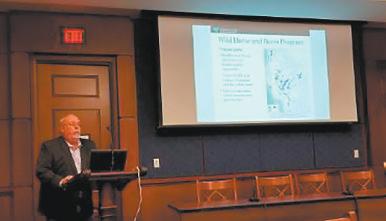
4 minute read
NV Society for Range Management - Healthy Horses on Healthy Rangelands
HEALTHY HORSES on Healthy Rangelands By Gary McCuin, Eureka County Extension Educator & Barry Perryman, Professor UNR, CABNR
In our first article this year we laid out the dismal statistics and general nature of Wild Horse & Burro (WH&B) management as it presently exists on federal lands. Too many horses, too much emotion, and too little management sums it up fairly succinctly. Yet we are optimistic, or maybe determined, that there are practical solutions. Toward that end, the Free Roaming Equids and Ecosystem Sustainability Network (FREES) has continued meeting through three working groups (Figure 1). These working groups originated from the 2019 Reno FREES Summit. Participants interested in seeking practical solutions to Wild Horse and Burro overpopulation and the resulting degradation of rangelands, wanted to continue the dialogue in order to explore potential solutions. FREES working Groups are: 1) Population Management Working Group, led by
Redge Johnson and Callie Hendrickson a. Assess and improve gathering methods and population growth suppression strategies b. Re-think the status quo for holding facilities and distribution of horses c. Identify and understand successful efforts for collecting and analyzing data 2) Rangeland Conditions and Habitat Working Group, led by Tracey Jean Wolfe a. Identify common misperceptions regarding federally defined Wild Horse and Burro habitat conditions b. Identify ecological and cultural “hot spots” 3) Outreach and Communication Working Group, led by Terry Messmer and Celeste Carlisle a. Develop collaborative committee focused on public messaging/education and congressional strategy b. Develop organizing structure and funding strategy for working groups. To date the group has created an endowment to secure long-term support for the network https://extension.usu. edu/freesnetwork/donate c. Develop a structure and process to build trust and consensus in FREES d. Complete a rigorous national survey of public perceptions about Wild Horse and their management Figure 1. FREES representatives (L-R) Gary McCuin, Barry Perryman, Terry Messmer, Callie Hendrickson and Tammy Pearson in Washington D.C.
A number of innovative and feasible ideas have emerged through their regular meetings. Those ideas will be brought forward by participants at the next FREES Summit October 6-8 in Cody Wyoming. Due to the Covid-19 circumstances, there is still uncertainty how this meeting will be accomplished, but there are plans for both an in-person meeting as well as virtual, or a hybrid of both. To join in the working groups and/or find out more about the FREES Network please go to https:// extension.usu.edu/freesnetwork/. The other development that we discussed in the first article was the “Path Forward.” The primary objective of this proposal is to develop an economically and environmentally viable, humane, non-lethal, and feasible long-term management plan for wild horses and burros. Authors of the “Path Forward” proposed the following solutions for the short and long-term health of our wild horses and burros along with our Western rangeland: (1) Relocate removed wild horses and burros to more cost-effective pasture facilities, (2) Contract with private parties to secure lower-cost leasing of land for long-term humane care of removed horses and burros, ( 3) Apply proven, safe and humane population growth suppression strategies to every herd that can be reached utilizing trained volunteers, Agency staff, and animal health professionals, as individual HMAs dictate to prevent repeated gathers and (4) Promote options to reduce captive populations and costs (Figure 2). We proposed a slightly different slant on the Public/ Private Partnership in our Rangelands article - Forum: A Framework for Resetting Wild Horse & Burro Management (Rangelands Vol 40 Issue 5 pgs. 129-170 (10/2018). The underlying problem for anyone taking on the care of a horse or burro, wild or domestic, is the associated cost. It takes “real” money to provide feed, water, health care, and shelter for a horse or burro, and the more of them you have the greater the cost, compounded by the fact that those costs are increasing every year. That is primarily why BLM off-range holding costs at current animal numbers exceeds 60% of the total Wild Horse and Burro (WH&B) budget. On the flip side, there is little to no financial return associated with warehousing WH&Bs. Possibly one of the reasons WH&B advocates continue to demand that the government shoulder 100% the burden. Our concept of a Public/Private Partnership is to get Congress to create “Green Tax” credits that an entity could contribute towards reducing their tax liability (Figure 3). Tax credits could only be utilized by an authorized caregiver to pay for the maintenance of WH&Bs with proof of life and would terminate upon the natural death of an identified animal. Through this funding mechanism all off-range holding costs to Bureau of Land Management (BLM) and U.S. Forest Service (USFS) could be eliminated from their budget, returning $52+ million dollars (at current inventories) to on-range management. In 20-30 years this program would sunset upon the demise of all off-range WH&Bs. This assumes that WH&B populations can be maintained at Animal Management Levels (AML) in the future through adoptions, fertility control, and diligent management.









